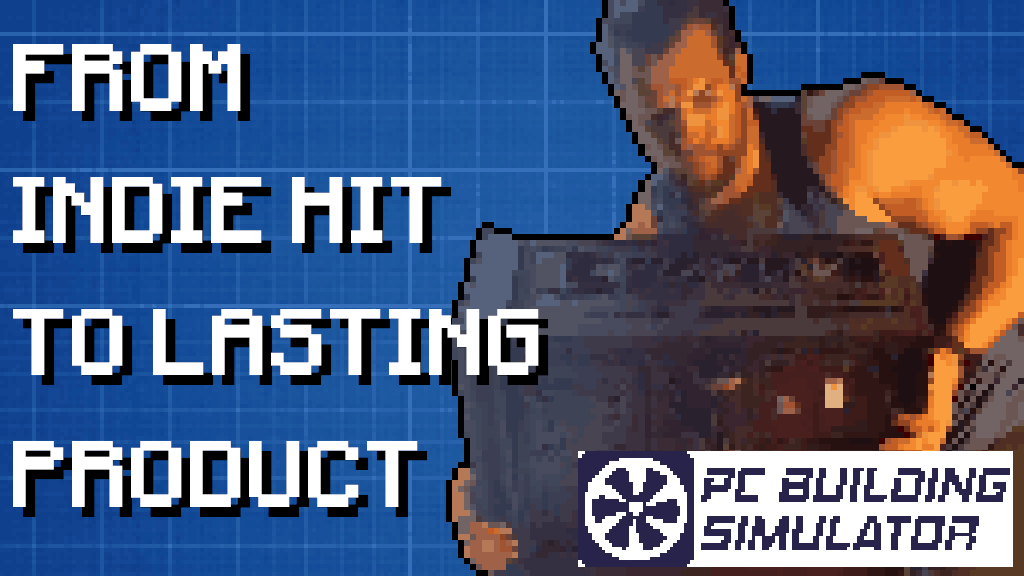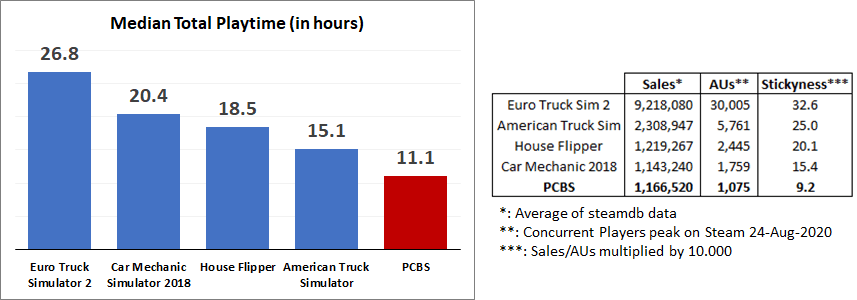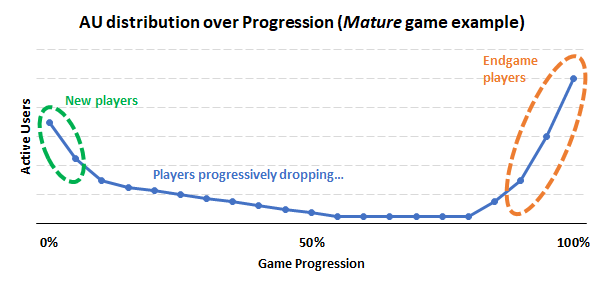
[DISCLAIMER] I'm not affiliated in any way to The Irregular Corporation or PC Building Simulator. The opinions on this article are my own and the data, unless stated otherwise, is made up to act as examples.
A few weeks ago I had the opportunity to speak with some of the masterminds behind PC Building Simulator. So I decided to play it for a bit. Just enough to get why there’s so many people streaming about it. It was a bad mistake: PCBS it’s addictive as hell.
Unfortunately, in my humble opinion, as it stands right now PCBS is far from achieving its full grossing potential, and not as good as it could be at maintain its current momentum: After a mere ~10h, the player has squeezed all the content from the main game & DLCs. And new content which adds meaningful reasons to stay is not added with enough periodicity to keep players engaged.

Purchase price offers and DLC releases generate population spikes (orange circles). Note how PCBS doesn’t transform much of that into regulars (green line). They do come in, but leave fast. Source.
Purchase price offers and DLC releases generate population spikes (orange circles). Note how PCBS doesn’t transform much of that into regulars (green line). They do come in, but leave fast. Source.
This article aims to explain what happens when a game reaches a maturity stage, and how to turn it into a service so it keeps generating revenue and maintains player interest for a longer time. What PCBS needs to go from a indie hit into a lasting product…
WHAT IS PC BUILDING SIMULATOR?
You might be surprise, but it’s actually slightly different than what it says on the tin. While the main interaction is about assembling components, the gameplay is in fact about running a PC repair shop.
Over the course of the Career mode & eSports DLC, the player has not only to tinker with PCs. But also listen to customer requests, diagnose broken PCs, check component prices to make sure the repair is kept under budget and manage delivery times…
Career causes most of the moments highlighted by streamers: Failing to diagnose why a PC doesn’t work, sending an expensive component to a customer for free, forgetting thermal paste…
PCBS has a simple core loop which is very effective at creating the just one more turn effect (fixing just one more PC, completing just one more day…).
As player progresses, harder jobs start appearing which may require to overclock the PC or even reach specific 3dMark scores… Unfortunately, that kind of content is quite limited: there are few mechanics to unlock, and not many shop upgrades to buy…

FREE MODE? A DEAD END!
PCBS does include a Free Mode where the player can relax by tinkering while disregarding component costs or profitability. Just enjoying the usage of real components from real brands.
This sandbox mode certainly appeals the most enthusiastic fans of PC building. But it offers very limited possibilities to generate broader player interest or sustain any monetization at all. It doesn’t provide reasons for the player to stay for long.
As a consequence, the creative direction seems to be putting the focus away from it: Their first major DLC is focused around eSports and puts emphasis on adding a new storyline and several extra game mechanics.
WHAT’S NEXT FOR THEM?
With sales estimations well above 1 million, it’s safe to say that PC Building Simulator has reached the status of an indie hit. But it takes more than that to become a lasting product.
ARE THERE ALTERNATIVES TO BE A LONG LIVED PRODUCT?
Maybe the developers would prefer a shorter lived product so they can release sequels, or even annual releases like FIFA…
However, I believe making sequential releases is not the way to go on the Simulation genre. Contrary to sport franchises, where rosters change every year, in Simulation themes there are few differences over a short span of time like a year.
So players would have few incentives to move towards the next product of the line.

The strategy of many sims is to keep products alive for a long time, and monetize further through DLCs.
The strategy of many sims is to keep products alive for a long time, and monetize further through DLCs.
With this I’m not necessarily saying that the developers shouldn’t work on a sequel. There are several problems with PCBS in terms of tech and core mechanics which might be easier to solve by starting from scratch…
But if they do a sequel, they should plan it in a way that it’s thought as a product that can sustain itself in the market for a long time, rather than a title on a list of sequels.
In that regard, PCBS faces two main challenges:
CHALLENGE #1: POST-PURCHASE MONETIZATION STRATEGY
So far, most of the revenue of PCBS comes exclusively from the purchase price.
Sales are boosted by regular discounts of a growing size, exploring every point of the price elasticity curve. A classic strategy which apparently has worked very well so far. This is great news on the short term, since PCBS still has several big bullets to shoot when it comes to discounts (they recently hit the -50% milestone, which means they still have -75%, -90%…).
But without the ability to successfully monetize further their already existing audience through post-purchase content, PCBS won’t be able to keep on performing on the long run. And right now, they are already leaving a lot of money on of the table, since their best customers are those that already payed for the game at higher price points.
CHALLENGE #2: INCREASE DAILY ACTIVE USERS
Active Users isn’t just a vanity metric.
Even if PCBS is a paid game, having a big population of highly engaged players means a broader potential market for DLC content (monetizing players further than just the purchase price) and more people speaking about it (fostering more people learning about the game and generating new purchases).
Fair: Regardless of how much we nerds love it, assembling PCs might not become a mainstream theme ever. (Even though, PC building is something growing in popularity, specially among younger audieces).
Last July, Henry Cavill (Superman, Geralt of Rivia…) uploaded a notorious video assembling a gaming PC build from scratch. He got 200% more views and comments than on his other videos.
FOCUS ON PLAYER RETENTION
Nevertheless, the opportunity with Active Users on PCBS is not related with the size of the niche, but with increasing the player retention.
We already saw the graph of the regular population growing very slowly. But there are several other engagement indicators that we can also use to infer that the player retention has significant potential to improve:

If we put the data from a few simulators in comparison, it doesn’t look too good for PCBS: Players seem to leave the game faster, and play less regularly than other sims. Are they depleting the content?
If we put the data from a few simulators in comparison, it doesn’t look too good for PCBS: Players seem to leave the game faster, and play less regularly than other sims. Are they depleting the content?
Improving this KPI would mean a massive change on the future performance of PCBS, opening the door for it to grow beyond its current grossing tier.
For example, Euro Truck Simulator 2 achieved a constant population growth over a very long time. Now, it’s in the Top 25 most played on Steam. They have more active players than on Red Dead Redemption 2 or The Witcher 3 (!!!)

Summarizing, to turn PCBS into a long lasting hit, there are 2 objectives:
Make players generate revenue after the game purchase (add monetization)
Keep players engaged for a longer time (improve retention)
How to achieve this?
First, let’s take a step back to examine the pieces we need to touch…
THE ANATOMY OF A MATURE GAME
Naturally, in games that are young and growing, there will be more new players in early stages than old players that have depleted the content and are located at the end. But eventually, as they advance, players will start to accumulate at the last point of the progression.
Over time, the flow of new players will become smaller than the amount of old players, and the DAU distribution will look something like this:

This would be a population snapshot of a single specific day on a mature game: new players come in, and then there’s a group of hardcore fans that accumulates at the end of the progression. Bursts of user acquisition, store featurings or discounts temporarily may alter the shape temporarily, but ultimately the older a game is, the more it will tend to look like a U or a J.



































